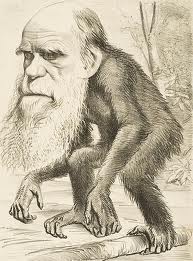When Darwin published On the Origin of Species in 1859, he suspected it would cause a storm of protest and indignation from religious quarters. He was right. Evolutionary studies, along with the new geological studies of the 19th century, posited the first awareness of “deep time,” as Stephen Jay Gould would later call it. It hypothesized that the earth was older, incredibly older, than had been previously thought. The evidence, corroborated by scientists then and since, has supported the hypothesis and shown that The Bible of the Christian church isn’t a reliable guide to the history of the planet.
Worse, from a Victorian point of view, was the evidence that man, along with the great apes, had descended from a common ancestor, through a long process of natural selection. One measured in millions of years for our branch alone.
Darwin had a hard time of it publicly and was lampooned in the newspapers of the day. But, continued studies through the next 150 years plus a new understanding of genetics, has shown that, with minor exceptions, Darwin got it right. For this he is justly honored for being one of the great figures of science.
Among scientists of natural history, the theory of evolution fits the facts, full stop. Nothing scientific has ever been put forward to challenge this point of view, and the so-called “gaps” put forward by those who don’t want to believe the facts, have been closed one by one as more discoveries have been unearthed. The fossil record and the genetic record are both consistent with evolution having taken place in the deep time of the planet Earth. To most scientifically literate people, the theory of evolution is as solid as the theory of gravity.
But there are still those who resist facing the facts. While visiting a cave in Arkansas last spring, I innocently asked our guide how long it took for the magnificent large limestone formation to form. She replied, “It depends on whether you believe in the ‘millions’ theory or the ‘thousands’ theory of the earth. I’m in the ‘thousands’ camp so I’d say a few thousand years.”
The “thousands” theory? This derives from Bishop James Ussher in the 17th century who speculated that the date of the Biblical Creation could be dated by calculating the lifespans of Old Testament patriarchs. Ussher’s conclusion was that the earth began on October 23, 4004 B.C. This totally Biblical calculation has somehow survived into present times, within sects of fundamentalist Christians who believe therefore that the earth is some 6000 or so years old, despite scientific (and rather obvious) evidence to the contrary.
What people choose to believe as an article of faith, rather than reason, is a basic right in the Western world. There are people who believe in the efficacy of quartz crystals and “power spots” as well. The problem begins when beliefs such as these spill out from personal and congregational spaces into public spaces.
You’d think that 150 years of solid evidence for the evolution of life on our planet, including our own evolution into Homo sapiens, would be sufficient reason for having it taught in schools. Yet there are still fundamental Christian lobbyists who want it taught alongside something they call “intelligent design.” Judge John Jones III ruled in the Dover, Pa., case in 2002, that “intelligent design, by its very nature, is a religious belief, not a scientific fact or theory, and therefore should not be taught in schools.” Intelligent Design is a tarted up name for Creationism — an attempt to give it scientific trappings.
But the debate continues. A recent Washington Times article, “On teaching evolution: New year, old fight,” reports that “at least two U.S. states in 2012 will consider bills that downplay the notion man evolved from animals and call for Charles Darwin’s famous theory to be taught as just that – one possible explanation, not the definitive answer.” Alongside Intelligent Design, that is.
Rep. Gary Hopper of New Hampshire is quoted as saying, “I want the problems with current theories to be presented so that kids understand that science doesn’t really have all the answers. They are just guessing.”
Guessing? If this is any indication of how some people think science works, it’s clear that we need more, not less, teaching of science and scientific literacy. Certainly science doesn’t have all the answers. That’s the nature of science. A scientist, like a good detective, follows the evidence, wherever it leads. In fact science is based on challenging the evidence. Whenever a new study emerges, other scientists try to pick it apart. If it withstands the challenges and is replicated by other scientific studies, a consensus forms around the results. If, eventually, evidence points to something entirely different, then previous views are updated and a new consensus is arrived at. In brief, science is self-correcting.
Religious faith does not operate this way. It instead harbors the concept of “immutable” truths. Which is not to say that a scientist can’t be a religious person. It’s just that he or she doesn’t confuse the two “magisteria” as Stephen Jay Gould would call the different mental spaces of science and religion.
That we live in an age of science is indisputable. And the scientific consensus is that Darwin got it right. There are no evidence-based challenges to evolutionary theory, only faith-based ones. To become good, participating citizens of a scientific world, students need to be taught how science works and not have their publicly-funded science studies entangled with the religious beliefs of fundamentalist Christian (or, for that matter, Islamic) faith.
In a modern world, church and state must be kept separate. The teaching of science must be taught in the context of following the evidence, not of comparing it to religious beliefs. To do anything else would be a disservice to the students.
